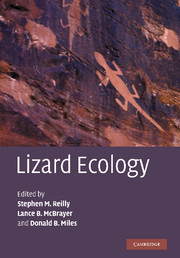Book contents
- Frontmatter
- Contents
- List of contributors
- Preface
- Historical introduction: on widely foraging for Kalahari lizards
- I Organismal patterns of variation with foraging mode
- II Environmental influences on foraging mode
- 12 The foraging biology of the Gekkota: life in the middle
- 13 Foraging mode in the African cordylids and plasticity of foraging behavior in Platysaurus broadleyi
- 14 Interactions between habitat use, behavior, and the trophic niche of lacertid lizards
- 15 Food acquisition modes and habitat use in lizards: questions from an integrative perspective
- 16 The evolution of foraging behavior in the Galápagos marine iguana: natural and sexual selection on body size drives ecological, morphological, and behavioral specialization
- 17 The evolution of the foraging mode paradigm in lizard ecology
- Index
- References
15 - Food acquisition modes and habitat use in lizards: questions from an integrative perspective
Published online by Cambridge University Press: 04 August 2010
- Frontmatter
- Contents
- List of contributors
- Preface
- Historical introduction: on widely foraging for Kalahari lizards
- I Organismal patterns of variation with foraging mode
- II Environmental influences on foraging mode
- 12 The foraging biology of the Gekkota: life in the middle
- 13 Foraging mode in the African cordylids and plasticity of foraging behavior in Platysaurus broadleyi
- 14 Interactions between habitat use, behavior, and the trophic niche of lacertid lizards
- 15 Food acquisition modes and habitat use in lizards: questions from an integrative perspective
- 16 The evolution of foraging behavior in the Galápagos marine iguana: natural and sexual selection on body size drives ecological, morphological, and behavioral specialization
- 17 The evolution of the foraging mode paradigm in lizard ecology
- Index
- References
Summary
Introduction
The four basic tasks, EPM, FAM, and habitat
One useful theoretical focus in evolutionary ecology is that an animal has four basic, autecological tasks: (1) find, acquire and utilize food; (2) avoid, evade, and deter predators; (3) cope with abiotic stresses and avoid abiotic extremes; and (4) acquire mates and reproduce. An integrative understanding would require knowing the relative influence of each of these tasks on the ecology of an individual, on the population, and on the evolution of higher taxa. In addition, it would be important to identify and understand how behavioral traits (ethotypes), physiological traits (physiotypes), and morphological traits (morphotypes) of animals are adapted to each of the four basic autecological tasks (Fig. 15.1). I refer to the sum of these traits as the EPM (the ethophysiomorph or ethophysiomorphotype). Among the four basic autecological tasks, food acquisition and utilization may be the primary, albeit sometimes indirect, cause for salient features of ethotypes, physiotypes, and morphotypes (and thus EPMs) of lizards and other animals (Anderson and Karasov, 1988).
The classic, general vertebrate mode of food acquisition as mobile, ectothermic predators on invertebrates continues to dominate in lizards (basal level in Fig. 15.1), and many features of lizards appear to be related to the basic autecological task of food acquisition (Pianka and Vitt, 2003). The set of physiological, behavioral, and morphological characteristics (the EPM) that are integrally involved in the search, detection, capture, and eating of food, may be considered an adaptive syndrome (Eckhardt, 1979) that I refer to as the “food acquisition mode,” FAM. An adaptive syndrome is a coordinated set of characteristics (adaptive traits) associated with an issue of overriding importance (a core adaptation) to an organism (Eckhardt, 1979).
Information
- Type
- Chapter
- Information
- Lizard Ecology , pp. 450 - 490Publisher: Cambridge University PressPrint publication year: 2007
References
Accessibility standard: Unknown
Why this information is here
This section outlines the accessibility features of this content - including support for screen readers, full keyboard navigation and high-contrast display options. This may not be relevant for you.Accessibility Information
- 20
- Cited by
